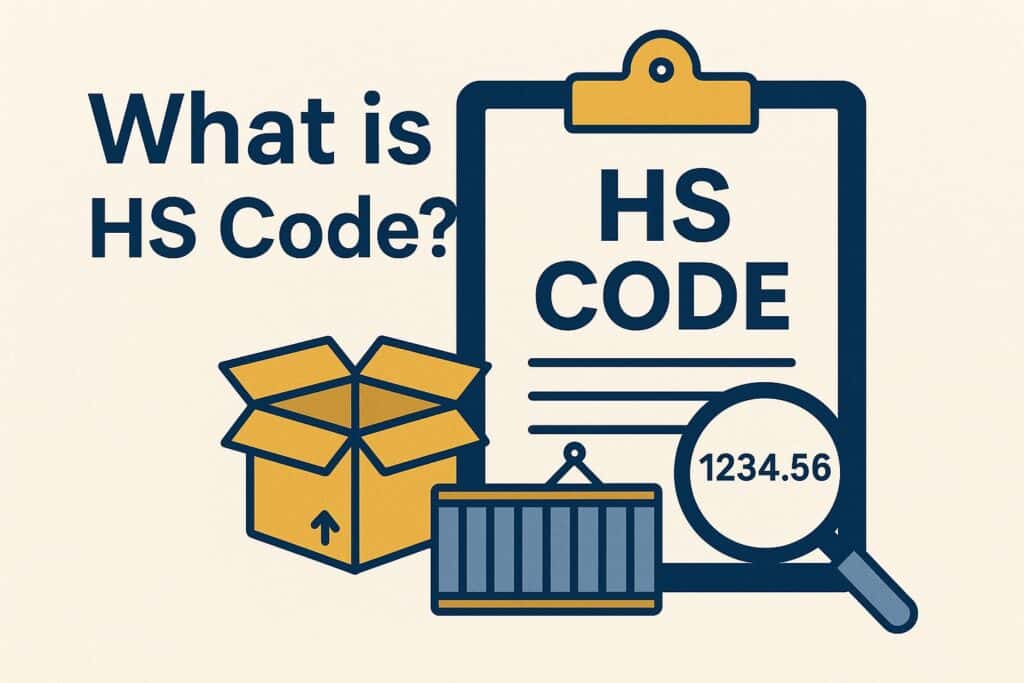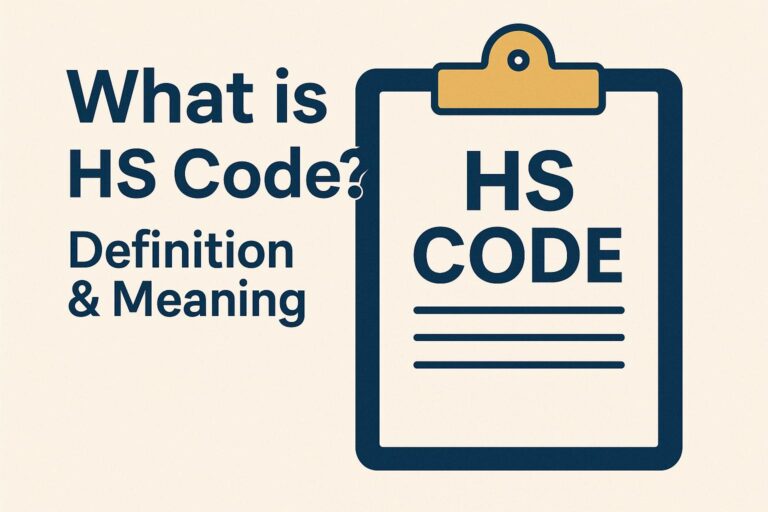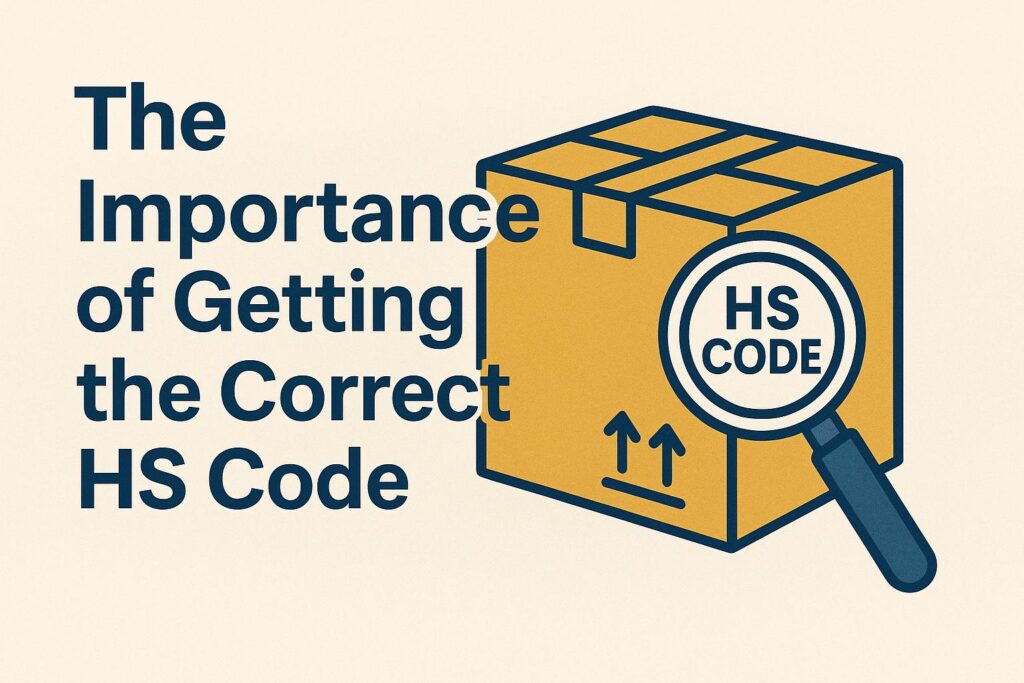If you’re involved in international shipping, you’ve probably encountered the term HS Code on shipping documents, customs forms, or commercial invoices. But what exactly is an HS code—and why does it matter?
An HS Code, or Harmonized System Code, is a standardized numerical system used by customs authorities around the world to classify traded products. From small businesses to multinational corporations, understanding the right HS code is critical for ensuring accurate customs clearance, calculating tariffs, and complying with import/export regulations.
In this comprehensive guide, we’ll explain:
What an HS code is and how it’s structured
Why choosing the correct code is essential
How different countries and free trade agreements rely on HS codes
Common mistakes to avoid—like using a wrong HS code
Real-world examples to help you understand the system
Let’s dive in.

What is HS Code and Why It Matters in Global Trade
What Is an HS Code?
In the complex world of international trade, HS codes—short for Harmonized System codes—serve as a universal language to classify and identify traded products. Whether you’re importing electronics, exporting textiles, or shipping mechanical appliances, the correct HS code ensures your goods clear customs smoothly and comply with regulatory requirements.
Every product that crosses a border must be assigned a code from the Harmonized System, an internationally standardized system developed to streamline global commerce.
Why Are HS Codes Important?
Without an accurate HS code, your shipment could face delays, incorrect tariffs, or even penalties. From calculating tariffs to compiling trade statistics, HS codes form the backbone of customs procedures in nearly every country. As trade expands across different countries, understanding this system isn’t just helpful—it’s essential.
What is HS Code? Definition & Meaning
The HS Code, short for Harmonized System Code, is an internationally recognized system for naming and classifying traded goods. Developed and maintained by the World Customs Organization (WCO), this coding system ensures that every product moving across borders is categorized uniformly, regardless of the country of origin or destination.
At its core, an HS code consists of a series of six digits, with some countries adding additional digits for more specific classifications. These numbers represent a product’s category and subcategory in numerical order, making it easier for customs authorities to determine tariff rates, import privileges, and regulatory requirements.
Structure of an HS Code:
First 2 digits: Identify the product category (e.g., mechanical appliances)
Next 2 digits: Define product subcategories
Last 2 digits: Specify further details, often related to product variations or materials
For example, an HS code like 8471.30 refers to “Portable digital automatic data processing machines,” such as laptops and tablets.
The HS code system is a vital part of global international trade. It enables trade statistics tracking, helps implement trade agreements, and ensures accurate customs clearance. Without this structure, it would be nearly impossible to process the millions of goods that move between countries daily.
Finding the correct code for your product is essential for compliance and avoiding penalties.

Who Develops HS Codes?
What Is the Role of the World Customs Organization (WCO)?
The Harmonized System (HS) is governed by the World Customs Organization (WCO), an intergovernmental body headquartered in Brussels, Belgium. The WCO is responsible for maintaining the HS nomenclature, issuing updates, and resolving disputes between member nations. Currently, over 200 countries and economies use the HS system, accounting for more than 98% of global trade.
How Countries Customize HS Codes
Each country adapts the core six-digit HS code to its own national customs system. For example:
The United States uses the Harmonized Tariff Schedule (HTS) and Schedule B codes.
The European Union applies the Combined Nomenclature (CN) format.
Other countries might include additional digits to classify products more precisely.
Despite these adaptations, the first six digits remain harmonized globally, allowing customs authorities to identify goods accurately and apply consistent trade policies. This coordination is critical for enforcing free trade agreements, setting tariff codes, and collecting import statistics.
Without the WCO’s centralized oversight, the global classification of traded products would be chaotic, leading to inconsistent procedures, incorrect tariffs, and frequent disputes among countries.
Structure of HS Codes: How Many Digits?
At first glance, an HS code may look like a random string of numbers—but its structure is highly systematic. The standard Harmonized System is made up of six digits, which are universally recognized. These digits form the foundation of the global product classification system and are used by customs departments in nearly every country. HS codes are used by customs authorities to apply tariffs and taxes accurately.
Breakdown of the HS Code:
First 2 digits (Chapter): Represent the broad product category (e.g., “01” = live animals)
Next 2 digits (Heading): Narrow down the product type (e.g., “0101” = horses, asses, mules)
Final 2 digits (Sub-heading): Offer even more specific classification (e.g., “010121” = purebred breeding horses)
This six-digit standard is followed globally. However, countries often append additional digits to meet their local needs:
The U.S. Harmonized Tariff Schedule (HTS) adds four digits, resulting in a 10-digit code.
The EU Combined Nomenclature (CN) adds two digits to form an 8-digit code.
Some trade agreements or regulatory requirements demand even finer classification.
These sub-headings, legal notes, and numerical orders ensure the system is both standardized and flexible. While the first six digits are consistent across nations, the added digits allow different countries to apply tariffs, restrictions, or benefits unique to their imported goods.
Using the correct number of digits—and the correct structure—is crucial for:
Preventing incorrect classification
Complying with general rules of interpretation
Avoiding costly customs clearance errors
In summary, key points to remember when dealing with HS codes include understanding the importance of correct classification, adhering to general rules of interpretation, and ensuring compliance with both international and local tariff regulations.
How HS Codes Are Used
HS codes play a crucial role throughout the global supply chain. From manufacturers to freight forwarders to customs authorities, every participant in international commerce relies on the Harmonized System to accurately identify and process goods.
HS codes are essential for tracking and managing imports, ensuring compliance in customs procedures and avoiding penalties.
Key Uses of HS Codes:
1. Customs Clearance
When goods cross borders, customs authorities use the HS code to determine:
Whether the product is allowed into the country
What tariffs or duties apply
Whether the product qualifies for import privileges or is considered a controlled good
Accurate HS coding ensures smooth customs clearance and avoids unnecessary inspections, delays, or fines.
2. Tariff Calculation
The HS code determines the rate of customs duty and applicable import taxes. Incorrect codes can lead to:
Overpayment or underpayment of duties
Penalties for wrong HS code usage
Loss of eligibility for trade agreements like free trade zones
3. Shipping Documents & Trade Compliance
HS codes are required on key documents such as:
Commercial invoices
Bills of lading
Certificates of origin
This information supports the enforcement of regulatory requirements and enables border agents to verify shipments.
4. Trade Statistics & Data Analysis
Governments and international organizations use HS codes to track trade statistics, monitor economic trends, and develop trade policies. Accurate coding enables reliable analysis of:
Import/export volumes
Product-level trade flows
Economic performance by sector
HS Code Example: Mechanical Appliances & Parts Thereof
To better understand how HS codes work in practice, let’s examine a real-world example from Chapter 84 of the Harmonized System, which deals with mechanical appliances and related equipment.
The classification of goods once exported depends on their HS codes.
Example:
Let’s say you’re exporting a laptop computer.
The correct HS code might be: 8471.30.0100
Here’s how it breaks down:
84 – Machinery and mechanical appliances; parts thereof
8471 – Automatic data processing machines and units thereof
8471.30 – Portable digital automatic data processing machines
8471.30.0100 – Laptops (specific national extension, e.g., in the U.S. HTS)
If you were instead shipping just the parts thereof, such as a laptop battery, the code might change to 8473.30, which represents parts and accessories.
Using the correct HS code is essential here, because:
Different items (e.g., full machines vs. parts) may face different tariffs
Misclassification could result in delays or fines
Some components may be subject to import restrictions, especially in high-tech or sensitive categories
More Examples:
Live animals: Chapter 01 (e.g., 0101.21 – Purebred breeding horses)
Fibrous cellulosic material: Chapter 47 or 48 depending on the product form
Articles thereof: Often listed in subsequent headings related to materials
Knowing the exact classification is not always straightforward. That’s why many companies use expert customs brokers or HS code lookup tools to avoid the risk of incorrect code usage.
The Importance of Getting the Correct HS Code
Choosing the correct HS code is more than a technicality—it’s a legal and financial necessity in international trade. An error in product classification can lead to a range of costly consequences that affect everything from shipping speed to legal compliance.
Why Accuracy Matters:
Avoid Overpaying or Underpaying Duties
An incorrect code might assign a higher duty rate, increasing your landed cost. Conversely, underpaying may trigger customs audits, back payments, or fines.
Ensure Smooth Customs Clearance
Customs officials rely on HS codes to determine admissibility, restrictions, and regulatory requirements. A wrong HS code could cause:
Shipment delays
Inspections
Rejections or returns of goods
Qualify for Trade Benefits
Under free trade agreements or special tariff programs, the right HS code is essential to benefit from:
Duty exemptions
Reduced tariff rates
Faster processing times
Avoid Penalties and Legal Risks
Incorrectly classified goods may violate customs laws. In some countries, persistent errors or incorrect classification can lead to:
Seizure of goods
Revocation of import privileges
Criminal liability
Common Causes of HS Code Errors:
Misinterpreting the legal notes or general rules of classification
Copying codes from other countries without verifying local requirements
Guessing based on product appearance instead of detailed specifications
To avoid these risks, many exporters rely on HS code databases, product catalogs, or consultation with customs authorities to identify the right HS code with confidence.
Learn more:
What does CNF Mean? Differences from FOB and CIF
Documents Required to Import from China (2025 Guide)
FOB Shipping Point vs. FOB Destination: Key Differences and Overview
DDP vs DDU vs DAP: Key Differences Explained (2025 Guide)
Delivered Duty Unpaid (DDU): What It Is and How It Works (2025 Guide)

HS Code and Trade Agreements
HS codes are the backbone of how free trade agreements (FTAs) are enforced. Without the correct code, importers and exporters may miss out on substantial tariff reductions and preferential treatment offered by such agreements.
How HS Codes Enable Trade Agreements:
Most trade agreements—such as the USMCA, EU Free Trade Agreements, or ASEAN Trade in Goods Agreement—are negotiated based on product classifications defined by HS codes. These agreements specify:
Which goods qualify for reduced or zero duties
Under what conditions the benefit applies
Country of origin rules, often linked to specific Schedule B or HTS codes
Examples of Tariff Schedules & Agreements:
Harmonized Tariff Schedule (HTS) – U.S. import tariff system based on HS codes
Schedule B – Used in the U.S. for export reporting
Harmonized Tariff Schedule of the EU (CN) – For European customs
If your product’s HS code is incorrect, you risk:
Losing tariff exemptions
Being disqualified from import privileges
Delaying shipments due to trade verification failures
Importance of Accuracy in Trade Programs:
For businesses that rely on preferential trade arrangements, getting the HS code right can mean the difference between saving thousands in duties—or paying unnecessary fees. Especially in competitive industries like electronics, textiles, or mechanical parts, the correct code directly impacts profitability.
Common Challenges in HS Code Classification
Despite being a globally standardized system, correctly classifying a product under the HS code structure can be surprisingly complex. Even experienced exporters and importers occasionally encounter confusion or errors—especially with new, hybrid, or multi-functional products.
Common Classification Challenges:
1. Ambiguous Product Descriptions
Many products can fall under more than one heading depending on how they are described. For example:
A multifunctional printer could be classified under printing machines or data processing equipment.
A coated paper product might be categorized by material or by its function.
2. Incorrect Code Reuse Across Countries
Businesses often assume an HS code used in one country applies globally. While the first six digits are harmonized, additional digits vary by country. Misapplying a full code from one region to another can lead to incorrect classification.
3. Overlooking Legal Notes and General Rules
Each HS chapter includes legal notes, general rules of interpretation, and explanatory notes. These provide essential guidance on how to classify complex products but are frequently ignored or misunderstood.
4. Frequent HS Code Updates
The World Customs Organization (WCO) updates the HS nomenclature every 5 years. If your classification is outdated, it may no longer be valid under current customs law, causing customs clearance issues.
5. Language Barriers & Local Variations
Descriptions and terms may differ across countries or languages. A term like “fibrous cellulosic material” may not translate clearly, leading to misclassification.
Consequences of Classification Errors:
Incorrect duties or taxes
Delays in delivery
Regulatory violations
Rejection of shipping documents
Lost opportunities under trade agreements
To mitigate these risks, it’s essential to cross-reference:
Tariff schedules of the importing country
Product catalogs and materials
Guidance from customs authorities or licensed brokers
FAQs on HS Codes
To help you navigate the complexities of HS codes, here are answers to some of the most frequently asked questions by importers, exporters, and logistics professionals.
What does HS code stand for?
HS code stands for Harmonized System code—a globally recognized method for classifying traded products using a numerical format. It is managed by the World Customs Organization and used by over 200 countries.
Is HTS code the same as HS code?
Not exactly. The HTS code (Harmonized Tariff Schedule) used in the United States builds upon the HS code by adding four additional digits for national-level classification. The first six digits of an HTS code are the HS code.
What is a Schedule B code?
Schedule B codes are used by the United States to classify products for export purposes. Like HTS, Schedule B codes are based on the HS structure but may differ in the last four digits.
How do I find the correct HS code for my product?
You can:
Use official tariff lookup tools provided by customs authorities
Refer to product catalogs with pre-classified codes
Consult a licensed customs broker for complex or controlled goods
Can the same product have a different HS code in different countries?
Yes—for the first six digits, the classification is harmonized. However, the extra digits may differ by country to reflect local trade rules, regulatory requirements, or industry-specific tariffs.
What happens if I use the wrong HS code?
Using a wrong hs code can result in:
Customs delays
Fines or audits
Overpayment or underpayment of duties
Loss of import/export privileges
Are HS codes required on all shipments?
Yes. Whether you’re shipping mechanical appliances, live animals, or fibrous cellulosic material, every product must be assigned an HS code for customs clearance, trade statistics, and tariff calculation.
Conclusion: Why HS Code Accuracy is Critical for Your Business
In today’s interconnected world, HS codes are the key to seamless international trade. From calculating the correct tariffs to complying with customs regulations, accurate product classification using the right HS code can directly impact your bottom line.
Whether you’re a small exporter or a global manufacturer, here’s why HS code accuracy matters:
It ensures faster customs clearance and avoids costly shipment delays.
It protects your business from penalties, incorrect classification, and audit risks.
It allows you to take full advantage of free trade agreements and import privileges.
It supports clear and transparent shipping documentation, critical for global compliance.
Getting the right code isn’t just about ticking a box—it’s about protecting your profits, reputation, and compliance status. As trade regulations continue to evolve and new products enter the market, investing in proper HS code classification is no longer optional—it’s essential.
Whether you’re exporting mechanical parts, importing controlled goods, or analyzing trade statistics, mastering HS codes is one of the smartest moves your company can make in global commerce.


